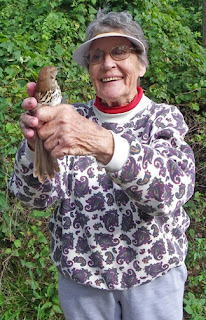I write this on September 11th, a day I spent in the same place doing my part of the BSBO mission in 2001. It is impossible not to remember the tragedy 10 years ago in New York City, Washington D.C., and in western Pennsylvania. We are very thankful for our freedom and for those who are on the frontlines every day ensuring those freedoms we often take for granted. It is these freedoms that allow us to appreciate the natural world, a natural world we have the responsibility to protect and conserve.
This responsibility is reflected in Aldo Leopold's Land Ethic, where community is people and wild places including animals, plants, land, and water.
 |
| Cape May Warbler |
Understanding migrational timing and the interaction of habitats of birds in migration is what BSBO continues to investigate to fill our role in the big picture of conservation.
 |
| Chestnut-sided Warbler |
 |
| One of the last Yellow Warblers seen before spring |
This week had a slow start with the remnants of Hurricane Lee hanging to our east. You could see the influx of migrants coming into the marsh region. Even with a strong Northeaster the birds could be seen and heard crossing the lake. The Observatory, which is about a half mile off the lake, had a large influx of migrants on Tuesday September 6th. We saw the diversity of warblers and thrushes on the Navarre beach ridge but the birds moved inland fast that day to escape the strong lake winds. By the 9th, with west winds the beach ridge took center stage.
Highlights for the week were 19 species of warblers and four of the brown thrushes (Wood (WOTH), Veery (VEER), Gray-cheeked (GCTH), and Swainson's (SWTH)). The warblers included Black-throated Green (BTNW), Wilson's (WIWA), Tennessee (TEWA), Cape May (CMWA), Blackburnian (BLBW), American Redstart (AMRE), Black-throated Blue (BTBW), Northern Waterthrush (NOWA), Blackpoll (BLPW), Magnolia (MAWA), Ovenbird (OVEN), Common Yellowthroat (COYE), Nashville (NAWA), Chestnut-sided (CSWA), Black-and-white (BAWW), Mourning (MOWA), Connecticut (CONW), Bay-breasted (BBWA), and Yellow (YEWA). Blackpolls and Magnolia warblers dominated the warbler scene this past week. Blackpolls have only just begun to arrive and will be picking up in the coming weeks.
Here is a quiz bird to keep you sharp:
Note the distinctive facial pattern and it's wing bars... Color should not be needed for the identification of this hatching year bird.
And to show you that there really are Connecticut Warblers out there. We share two caught at the same time. Note the larger bill and the complete eye ring.
It is always interesting to observe two similar species up close to compare their distinguishing features. Take a look at this NAWA and MOWA. Note the size of the two species, plus where the yellow appears on the front of each (the yellow goes all the way up the throat on the NAWA and the MOWA has the hood coloration on its throat), also the complete eye ring of the NAWA and the split eye ring of this hatching year MOWA.
 |
| NAWA left and MOWA right |
This week saw the capture of three species of vireos including Red-eyed (REVI), Warbling (WAVI) and Philadelphia (PHVI). Note that the yellow on the PHVI extends all the way from the belly to the bill. The WAVI may have yellowish wash along the flanks but does not see yellow extend to the bill.
 |
| Philadelphia Vireo |
 |
| Philadelphia Vireo front view |
Next weekend begins the Midwest Birding Symposium and fall migrants should start to peak in numbers and diversity. Get out and enjoy the season and take time to share your love of birds with someone new!
Banding demonstrations at the Observatory are on Friday and Saturday from 8 AM to 9:30 AM. This is a great opportunity to see those confusing fall warblers up close.
Answer to the quiz bird is Hatching Year female Blackburnian Warbler.
 |
| After Hatch Year male Blackburnian Warbler |




















































